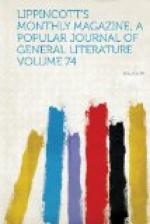The Platte, which ran through the meadow about a quarter of a mile away, was a brown, shallow stream, twenty feet wide, fretting over a rocky bed, with little pools and rapids which had a promising look; so we looped on a red and a brown hackle and began to cast. Levell walked down stream about a quarter of a mile before he began, so as to leave a piece of water for the Scribe. The sun shone very bright and hot, and only a few small trout answered my invitations. They were darker and less brilliant in color than our Salmo fontinalis, and were, I think, Salmo Lewisii, which inhabits these waters. The valley was about half a mile wide, and shut in on each side by mountains of red granite, crowned with pines. Bailey’s people were making hay in the valley, and I sat down on a fragrant haycock to await the return of my companion. Presently I observed a horseman coming up the valley: he was a hunter, followed by a couple of hounds, with the carcass of a mountain-sheep, or bighorn (Ovis montana), on the saddle in front of him. He told me he had killed it on the mountain behind us, and was taking it to Bailey’s for sale. It was an animal something in color like a deer, and about as heavy, though shorter in the leg, with very large curved horns, like those of a ram. He said they were numerous in these mountains, and he had killed six of them in a day, but had to lower them down the precipices with a lariat, which was hard work. I asked if the story was true that these creatures would throw themselves from high rocks, and, turning over in the air, pitch upon their horns with safety. He said he had hunted them many years, but never saw that performance. Being asked if he thought they could do it, he replied that he reckoned they could, but would be smashed if they did. Being interrogated on the subject of grizzly bears, he replied that there were grizzlies hereabouts, but that he never hunted them: he had no use for grizzlies.
In a couple of hours Levell returned, having fished the stream for a mile or more: he had got about twenty small trout. We found that Sepia had been more successful than ourselves, for she had made some effective water-color sketches of the scenery.
Aug. 21. We started this morning at seven, and drove up the Platte Valley five miles to Slaight’s, through a very picturesque region. Passed some heavy wagons bound to the mines, and met the mail-stage coming down the valley from Fairplay, with four horses at a gallop: we were luckily able to draw off and let them pass, which they did in a cloud of dust, through which could be dimly seen the long-bearded, red-shirted miners. A saw-mill at Slaight’s, with two houses and some fields of oats. Then eight miles to Heffron’s, at the forks of the river, where there are a post-office and one house. Two miles beyond we stopped to feed our horses in a lovely park-like bit of open forest of sugar pines. This species resembles the yellow pine of the Southern




